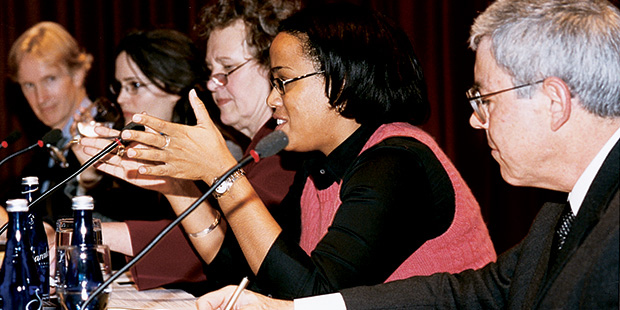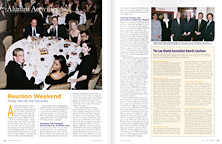The Impact of Grutter and Gratz
Two high-profile cases send mixed messages about the future of affirmative action
Printer Friendly VersionThe race-conscious admissions policies applied by the University of Michigan and the lawsuits that sought to eradicate those policies were the topics of discussion in a symposium sponsored by the Law Alumni Association and the Black, Latino, Asian Pacific American Law Alumni Association last fall.
Four attorneys who were involved in those cases, Grutter v. Bollinger and Gratz v. Bollinger, examined the question, “The University of Michigan Cases: What Do They Mean for Affirmative Action and Where Do We Go From Here?” In Gratz, the university’s undergraduate admissions program, which awarded underrepresented minorities bonus points on an admissions scale, was struck down as unconstitutional; in Grutter, a policy of conferring favor on individual minority applicants to the university’s law school was upheld.
Melissa Woods, assistant counsel at the NAACP Legal Defense and Educational Fund, represented student intervenors in the Gratz case and was deeply disappointed by the decision. Under the point system that was struck down, four of the five factors— school attended, curriculum, geography, and alumni legacy—favored white students, according to Woods. “Some sort of preference needed to have been done to make up for that difference.”
A majority of the panelists were supporters of the Grutter decision backing affirmative action. Miranda Massie (’96), who served as lead counsel for the student intervenors in Grutter, said she made arguments in that case about the necessity of affirmative action in today’s society “that continues to be in many ways a caste society.” She attacked law schools’ reliance on LSAT scores for admissions, citing a study that showed white students score 9.2 points higher on the LSAT than students of color after controlling for college GPA and major. “It’s a test that has been proved to be racially biased,” Massie said. “To use it as a putative measure is completely unacceptable and a tool of re-segregating our society.” Thomas Gerety, executive director of the Brennan Center for Justice and former president of Amherst College, agreed with Massie that the LSAT might be biased against people of color, but he argued that law school admissions boards are unlikely to abandon it. The question, he said, is what should be done about the bias?
Panelist Manuel Klausner (’62, LL.M. ’63), general counsel of the Individual Rights Foundation and an affirmative action opponent who filed amicus briefs in both cases, said that until Grutter, a strict scrutiny standard existed for finding a compelling state interest in upholding affirmative action policies. “The Court abandoned the whole concept of using strict scrutiny, and race was allowed to be used. I submit that the case, at bottom, was a political decision.”
Massie and the others saw it differently, arguing that Grutter was a good decision for the right reasons—and a case that will have a huge long-term impact.

